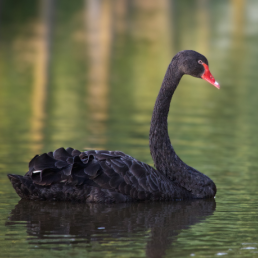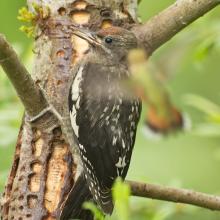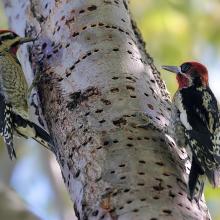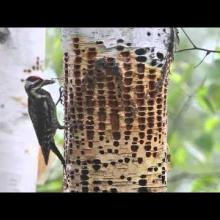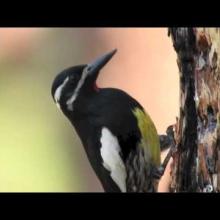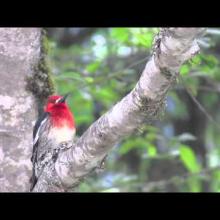

Join BirdNote tomorrow, November 30th!
Illustrator David Sibley and actor H. Jon Benjamin will face off in the bird illustration battle of the century during BirdNote's Year-end Celebration and Auction!
Sapsuckers drill small holes in the bark of favored trees, then return again and again to eat the sap that flows out. And hummingbirds, kinglets, and warblers come to the sap wells to eat the insects trapped in the sap. Although a sapsucker - like this Red-breasted Sapsucker - may suck a tree's blood, so to speak, the drilling usually doesn't damage an otherwise healthy tree. You can learn about sapsuckers and other woodpeckers at Cornell's All About Birds.
BirdNote®
Sapsuckers
Written by Dennis Paulson
This is BirdNote!
[Drilling and call of Red-breasted Sapsucker]
When you hear this drilling and catlike squeal, look for a delicate woodpecker – a sapsucker. Depending on where you live, you’re most likely to see one of three species. The Yellow-bellied lives in the East, Red-naped in the Rockies, and Red-breasted on the Pacific Coast. Each of them quietly drills small holes in the bark of favored trees, then returns again and again to eat the sap that flows out.
Although a sapsucker sucks the tree’s blood, so to speak, the drilling usually doesn’t damage an otherwise healthy tree. The sapsucker also takes the small insects attracted to the seeping sap. And hummingbirds, kinglets, and warblers also come to the sap wells to feed. [Whirring wings of hummingbird] In this way, sapsuckers benefit other birds.
You can spot sapsucker trees by the horizontal rows of holes scattered up and down the trunk. These trees freeze in winter, so most sapsuckers are highly migratory.
[Sapsucker drumming]
When spring comes, sapsuckers become noisier, drumming like other woodpeckers but in syncopated rhythms. They seek out dead trees in mature forests in which to excavate their nest holes, and sipping sap gives way to foraging for insects.
[Squeal of a Red-breasted Sapsucker]
For BirdNote, I’m Mary McCann.
###
Call and drumming of the Red-breasted Sapsucker provided by The Macaulay Library of Natural Sounds at the Cornell Lab of Ornithology, Ithaca, New York, recorded by G.A. Keller. Wing beat of Anna’s Hummingbird recorded by A.A. Allen.
Producer: John Kessler
Executive Producer: Chris Peterson
© 2010 Tune In to Nature.org June 2010/2021
ID#061306RBSUKPLU sapsucker-01b
